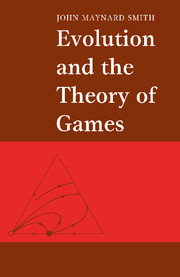Book contents
- Frontmatter
- Contents
- Preface
- 1 Introduction
- 2 The basic model
- 3 The war of attrition
- 4 Games with genetic models
- 5 Learning the ESS
- 6 Mixed strategies – I. A classification of mechanisms
- 7 Mixed strategies – II. Examples
- 8 Asymmetric games – I. Ownership
- 9 Asymmetric games – II. A classification, and some illustrative examples
- 10 Asymmetric games – III. Sex and generation games
- 11 Life history strategies and the size game
- 12 Honesty, bargaining and commitment
- 13 The evolution of cooperation
- 14 Postscript
- Appendixes
- Explanation of main terms
- References
- Subject index
- Author index
1 - Introduction
Published online by Cambridge University Press: 05 June 2012
- Frontmatter
- Contents
- Preface
- 1 Introduction
- 2 The basic model
- 3 The war of attrition
- 4 Games with genetic models
- 5 Learning the ESS
- 6 Mixed strategies – I. A classification of mechanisms
- 7 Mixed strategies – II. Examples
- 8 Asymmetric games – I. Ownership
- 9 Asymmetric games – II. A classification, and some illustrative examples
- 10 Asymmetric games – III. Sex and generation games
- 11 Life history strategies and the size game
- 12 Honesty, bargaining and commitment
- 13 The evolution of cooperation
- 14 Postscript
- Appendixes
- Explanation of main terms
- References
- Subject index
- Author index
Summary
This book is about a method of modelling evolution, rather than about any specific problem to which the method can be applied. In this chapter, I discuss the range of application of the method and some of the limitations, and, more generally, the role of models in science.
Evolutionary game theory is a way of thinking about evolution at the phenotypic level when the fitnesses of particular phenotypes depend on their frequencies in the population. Compare, for example, the evolution of wing form in soaring birds and of dispersal behaviour in the same birds. To understand wing form it would be necessary to know about the atmospheric conditions in which the birds live and about the way in which lift and drag forces vary with wing shape. One would also have to take into account the constraints imposed by the fact that birds' wings are made of feathers – the constraints would be different for a bat or a pterosaur. It would not be necessary, however, to allow for the behaviour of other members of the population. In contrast, the evolution of dispersal depends critically on how other conspecifics are behaving, because dispersal is concerned with finding suitable mates, avoiding competition for resources, joint protection against predators, and so on.
In the case of wing form, then, we want to understand why selection has favoured particular phenotypes. The appropriate mathematical tool is optimisation theory.
- Type
- Chapter
- Information
- Evolution and the Theory of Games , pp. 1 - 9Publisher: Cambridge University PressPrint publication year: 1982
- 3
- Cited by



